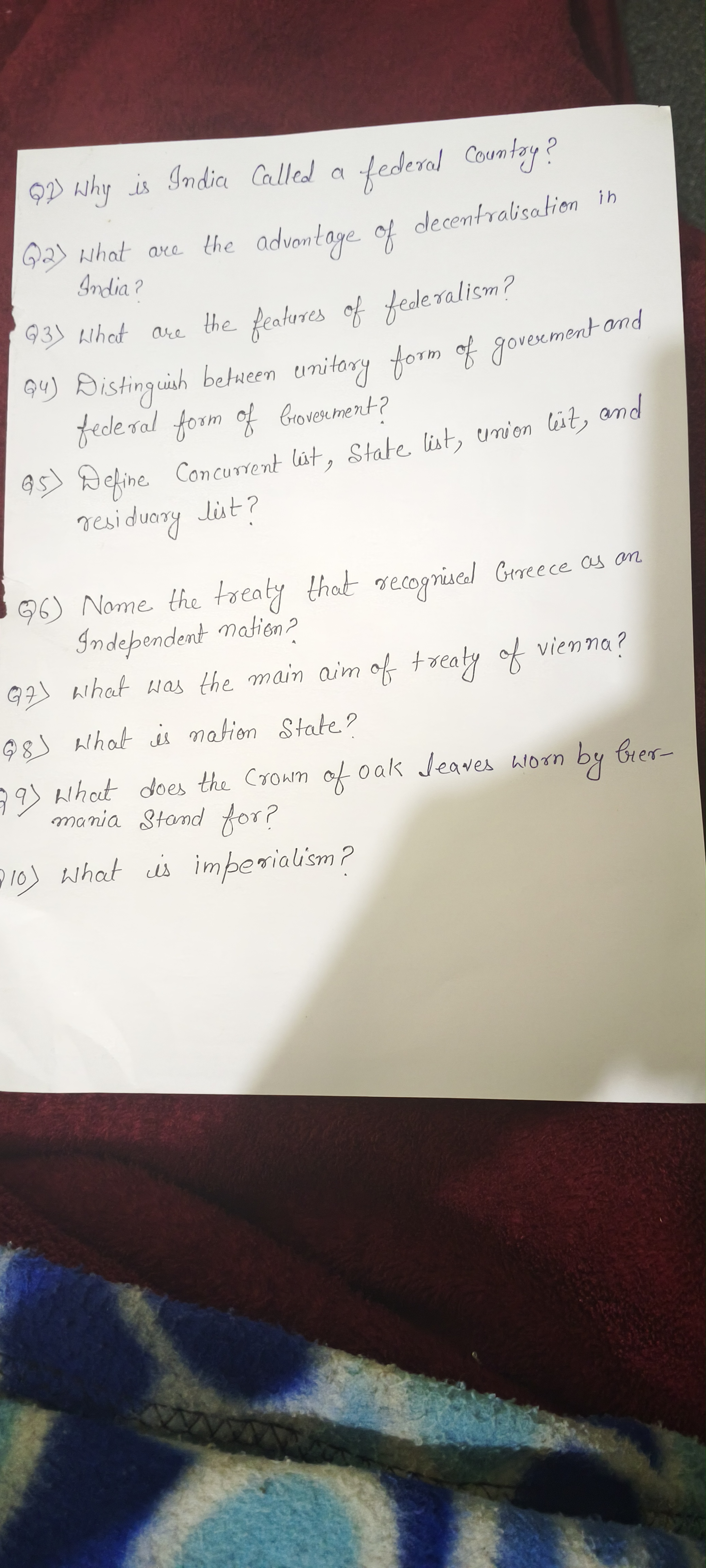1. Why is India called a federal country? 2. What are the advantages of decentralisation in India? 3. What are the features of federalism? 4. Distinguish between unitary form of go... 1. Why is India called a federal country? 2. What are the advantages of decentralisation in India? 3. What are the features of federalism? 4. Distinguish between unitary form of government and federal form of government. 5. Define Concurrent list, State list, Union list, and residuary list. 6. Name the treaty that recognised Greece as an independent nation. 7. What was the main aim of the Treaty of Vienna? 8. What is a nation state? 9. What does the crown of oak leaves worn by Germania stand for? 10. What is imperialism?

Understand the Problem
The question is asking for various historical and political concepts related to federalism, treaties, nation-states, and imperialism. This indicates a focus on political science and history, particularly within the context of India and European treaties.
Answer
1. Power division in India's constitution. 2. Decentralized governance benefits. 3. Power division, dual systems in federalism. 4. Unitary is centralized; federal is decentralized. 5. Lists define legislative powers. 6. Treaty of Constantinople. 7. Restore monarchies post-Napoleonic Wars. 8. Self-governing nation. 9. Germania's heroism. 10. Extending power through imperialism.
- India is federal because power is constitutionally divided between central and state governments. 2. Decentralization in India improves governance and participation. 3. Federalism features power division and constitutional supremacy. 4. Unitary is centralized, federal is divided. 5. Lists define legislative powers in India. 6. Treaty of Constantinople recognized Greece. 7. Treaty of Vienna aimed to restore European order post-Napoleonic Wars. 8. Nation-state is a self-governing nation. 9. Germania's crown symbolizes heroism. 10. Imperialism is extending a nation's power.
Answer for screen readers
- India is federal because power is constitutionally divided between central and state governments. 2. Decentralization in India improves governance and participation. 3. Federalism features power division and constitutional supremacy. 4. Unitary is centralized, federal is divided. 5. Lists define legislative powers in India. 6. Treaty of Constantinople recognized Greece. 7. Treaty of Vienna aimed to restore European order post-Napoleonic Wars. 8. Nation-state is a self-governing nation. 9. Germania's crown symbolizes heroism. 10. Imperialism is extending a nation's power.
More Information
India's federal structure allows for diversity in governance while ensuring a unified nation. Decentralization in India strengthens democracy by empowering local governments.
Tips
Confusing unitary and federal systems can lead to misunderstandings of government powers.
Sources
- What makes India a Federal Country?- Class 10 Polity Notes - geeksforgeeks.org
- Federalism in India - Federal Features of Indian Constitution - byjus.com
- Explained: Why is it said that India has asymmetric federalism? - thehindu.com
AI-generated content may contain errors. Please verify critical information